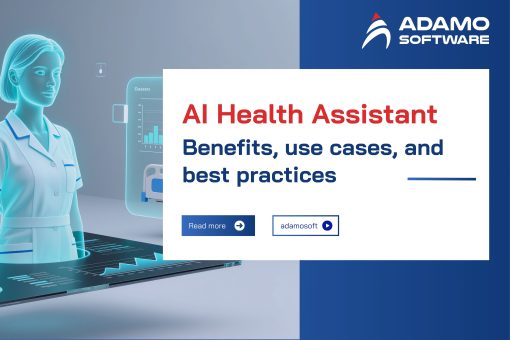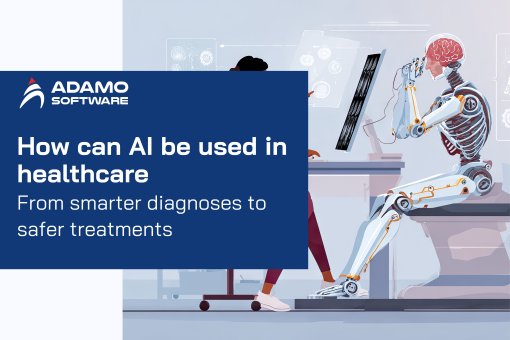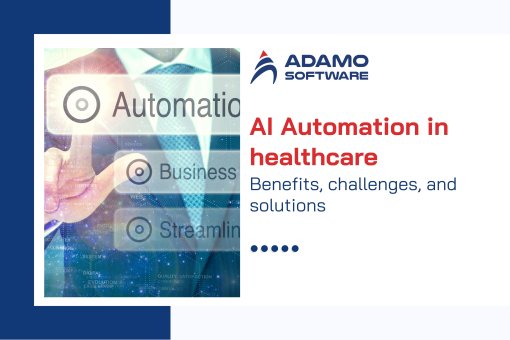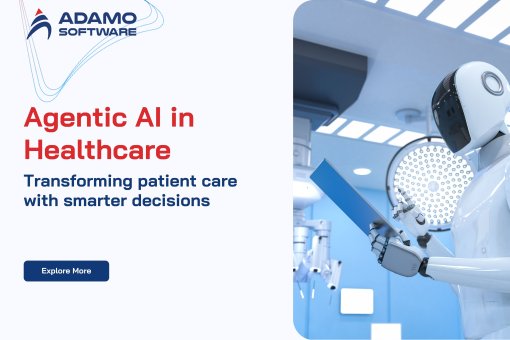RFID in Healthcare: Ultimate Guide in 2026
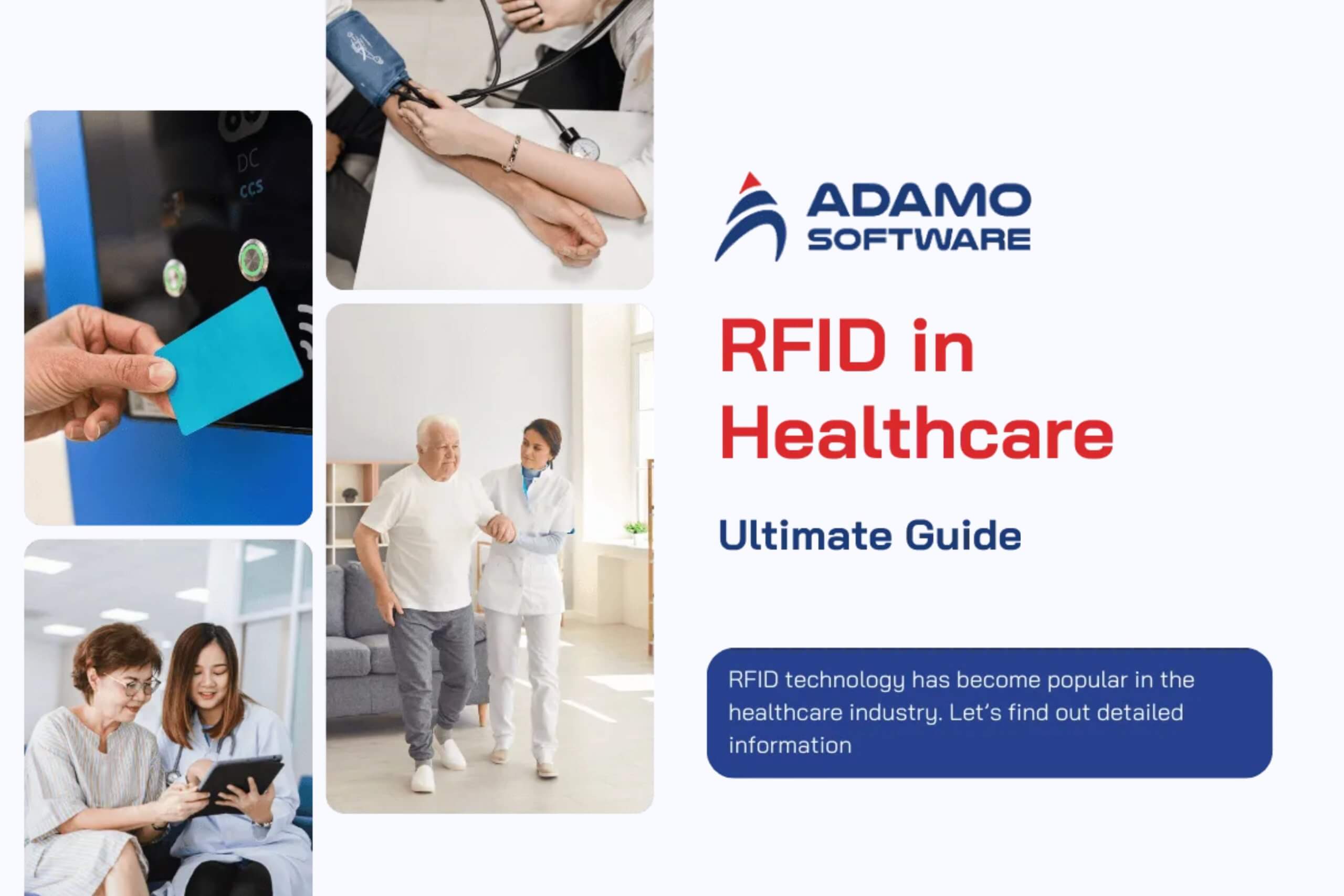
Radio Frequency Identification (RFID) technology has become more and more useful in the healthcare industry, bringing many improvements in clinical processes and administrative management. For healthcare facilities, patient tracking systems using RFID technology can transform the way they work. Their works include information management, real-time tracking, and available hospital beds, etc. Adopting RFID in healthcare can reduce or eliminate human error, create a more effective working process, and improve patients’ treatment outcomes from many angles. So, what exactly is RFID healthcare? Let Adamo Software answer this question.
Through this blog post, you will find out the definition of RFID in healthcare, and the benefits of using healthcare RFID. Some obstacles that healthcare facilities have to face when adopting RFID healthcare solutions are also mentioned. Besides, use cases of RFID in the healthcare industry, the way healthcare RFID works, and some must-have features of healthcare RFID are also discussed. Read our post for more detailed, well-researched, and up-to-date information.
I. What is RFID in Healthcare?
RFID in healthcare refers to wireless communication in which readers track and identify tags with encoded data of the healthcare sector. Each tag contains information about the item it is attached to which can be medical equipment, property, or a patient. The tag will broadcast this data to the reader. Therefore, RFID is not only a tracking method like barcodes but also has especially useful characteristics. The reader can read multiple tags at once and RFID allows identifying and calculating each item that the reader reads as a single unit.
Each time the reader reads RFID tags, those read data can be immediately transmitted to software hosted in the cloud or local networks. This means that authorized people within a medical institution can share these updated data in real time. In this way, patients, equipment, and assets with RFID tags can be tracked automatically and accurately at all times without human mistakes. When these pieces of information are combined with other applications, they can provide precise and time-tracked management and control. These applications include electronic patient records, bed availability databases, etc.
Overall, RFID in healthcare can improve efficiency, safety, and accuracy in various medical applications. Keep reading our post for more benefits of using RFID in healthcare.
You can explore more about Hospital Management Systems: Types, Key Features & Must-Know Insights here.
II. Benefits of Using RFID in Healthcare
Using RFID in healthcare brings many benefits to healthcare facilities. From enhancing inventory management for optimal patient care to reducing operational costs, RFID helps you all. Let’s have a look at each of the benefits.
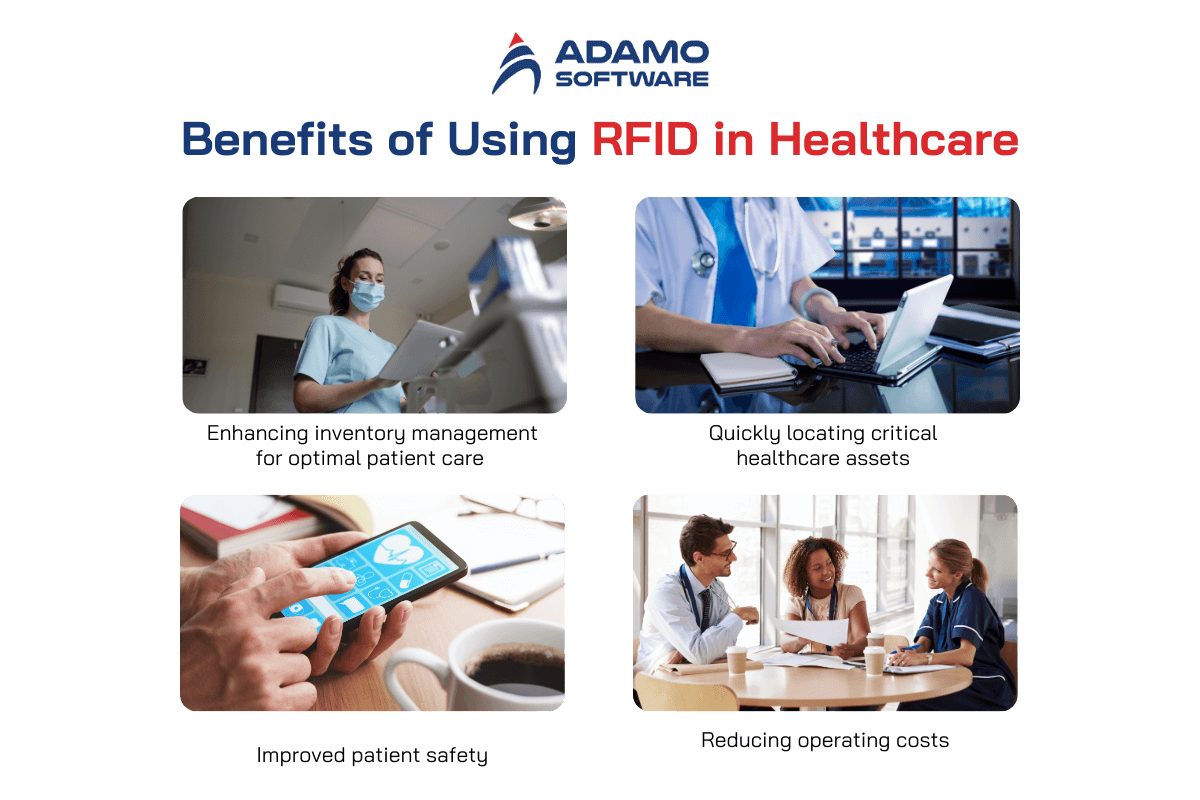
1. Enhancing inventory management for optimal patient care
Healthcare RFID ensures that medical supplies and equipment are always available when needed, which enhances inventory management and optimizes patient care. With RFID tags, healthcare facilities can monitor and manage their stock with greater accuracy and efficiency. These tags provide real-time data on inventory levels. Thanks to that, the risks of shortage or overstocking can be reduced. This guarantees immediate access to essential supplies like medications, surgical instruments, and personal protective equipment.
RFID in healthcare allows automating inventory tracking, which helps to reduce human errors and free up staff time. Instead of spending time and effort on administrative tasks, healthcare providers can focus more on patient care. Besides, by monitoring item usage and expiration dates, RFID reduces waste and ensures the use of safe, effective supplies for patient treatments. Thanks to efficient inventory management, healthcare facilities’ operations can run more smoothly. Besides, patient outcomes can also be enhanced with timely and accurate medical interventions.
2. Quickly locating critical healthcare assets
In addition to managing inventory, RFID in healthcare is also helpful in locating critical healthcare assets quickly. With RFID tags attached to medical equipment and devices, healthcare providers can track the real-time location of necessary medical equipment, such as defibrillators, ventilators, and infusion pumps. In case of emergency, rapid access to medical examination and treatment instruments can ensure that life-saving equipment is available without delay. This is thanks to the reduced time spent searching for equipment.
Besides real-time asset tracking, RFID also helps maintain a secure and efficient inventory by preventing valuable medical assets from loss or theft. Effective asset management accelerates response times in emergencies, enhances overall operations in medical institutions, and improves patient outcomes while boosting staff efficiency.
3. Improved patient safety
Improved patient safety is also among the outstanding benefits of using RFID in healthcare. RFID wristbands and tags guarantee precise patient identification, preventing medication and treatment errors. These errors include wrong-patient surgeries, medication mix-ups, wrong medication and treatment routes, misdiagnosis, etc. RFID limits these errors by providing real-time verification of patient information.
Through RFID, clinics and hospitals can track the patients’ movement when they transfer within the facility, prevent patient misplacement, and ensure accurate transportation for their patients. In addition, RFID aids in infection control by tracking hand hygiene compliance among healthcare workers. In general, the detailed data collected by RFID allows healthcare providers to make informed decisions about optimizing patient care and safety during their treatments.
4. Reducing operating costs
Adopting RFID in healthcare contributes to reducing the healthcare facilities’ operating costs. Thanks to RFID, there is no need to check inventory manually, cutting down the cost of managing supplies and equipment. By tracking medical assets in real-time, clinics and hospitals can prevent loss and theft, thereby lowering replacement expenses. Besides, effective inventory management by RFID prevents supply expiration, reducing waste and associated costs.
Additionally, by reducing medical errors and improving patient safety, RFID technology can lower the costs associated with legal liabilities, corrective treatments, and extended hospital stays. Overall, the streamlined operations and enhanced accuracy provided by RFID systems lead to significant cost savings for healthcare facilities.
III. Barriers to using Healthcare RFID
Although the use of RFID in the medical field brings many benefits to medical facilities, it also brings certain obstacles. These barriers are related to economics, technology, and organization.
1. Economic challenges
Many economic hindrances disrupt the adoption of RFID technology. Here are some of them.
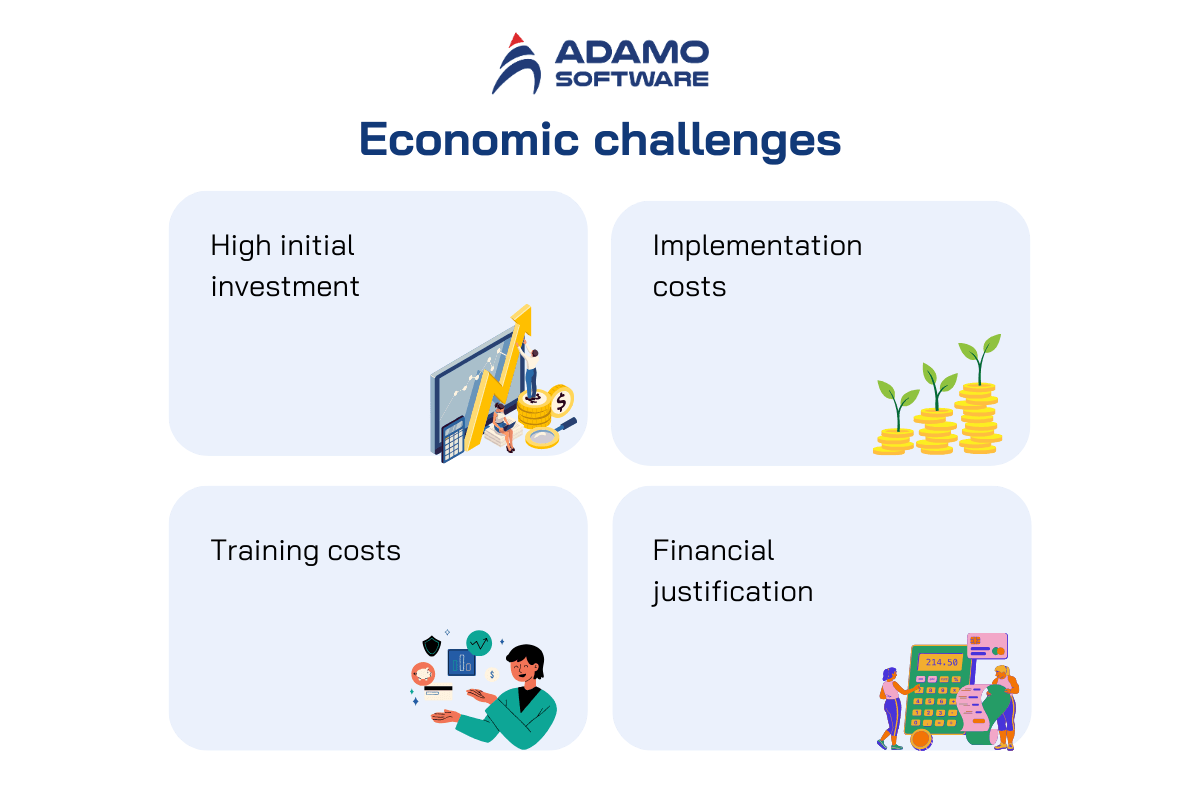
- High initial investment
The high initial investment is a significant barrier to implementing RFID technology in healthcare, as it requires a substantial expenditure on RFID tags, readers, and supporting hardware. Besides, not all IT systems and physical infrastructure of healthcare facilities are compatible with RFID technology. Therefore, they have to invest in upgrading these systems and facilities to effectively integrate and support RFID technology. In general, the initial investment required can be substantial, particularly for smaller healthcare facilities facing budgetary limitations.
- Implementation costs
Implementation costs for RFID in healthcare include the complex and costly integration of RFID systems with existing healthcare information systems. Additionally, the installation and configuration of RFID technology across an entire facility is time-consuming and requires significant labor resources, further driving up expenses.
- Training costs
When using the RFDI technology, healthcare facilities may want to train their staff to get familiar with the system. This requires substantial financial investment in initial training sessions and ongoing education. These training expenses add to the overall cost of adopting RFID, making it a significant consideration for healthcare facilities.
- Financial justification
Financial justification for implementing RFID in healthcare can be challenging. This is because demonstrating a clear return on investment (ROI) often requires long-term data and analysis. The financial gains can be hard to measure as the benefits of RFID may be intangible or realized over an extended period. The uncertain return on investment can hinder healthcare facilities from prioritizing RFID adoption among other critical budgetary needs.
2. Technological barriers
Besides the challenges in the economic sector, adopting RFID in healthcare also faces technological barriers. Here are some outstanding technical challenges.
- Interference and signal issues
RFID systems can experience interference from other electronic devices, medical equipment, and building materials. This affects the accuracy and reliability of data transmission within the healthcare facilities. Besides, the RFID signals can be blocked or weakened by physical obstructions, such as walls and metal objects.
- Integration with existing systems
As mentioned, RFID may be incompatible with the clinic’s and hospitals’ existing IT systems, such as electronic health records (EHR) and hospital information systems (HIS). Integrating RFID data with existing systems requires standardizing data formats and protocols. This can be technically demanding and resource-intensive.
- System scalability
Significant technological adjustments and resources are required to expand RFID systems so that they can cover more areas or additional healthcare facilities. Ensuring consistent performance and reliability as the RFID network grows can be challenging. This necessitates careful planning and robust infrastructure. In addition, to ensure optimal efficiency and effectiveness, larger RFID systems demand continuous technical support and maintenance to manage their increased complexity.
Overall, technical issues in using RFID in healthcare need to be addressed. This requires careful planning, investment in technical expertise, and ongoing support to ensure the successful implementation and operation of RFID systems.
3. Organizational barriers
Organizing and arranging work in medical facilities is also a challenge in using RFID in healthcare. The most obvious barrier is staff training and education. To ensure that all healthcare staff can effectively use the new RFID technology, healthcare facilities must hold comprehensive training programs. This may be time-consuming and resource-intensive. Ongoing education is necessary to keep staff updated on system upgrades and new features, requiring a sustained commitment to training.
The next obstacle is that the workflow will be interrupted. Implementing RFID can temporarily disrupt existing workflows as staff adapt to new processes and systems. To fully leverage RFID technology, organizations may need to redesign their operations, which can be a complex and challenging process. Additionally, RFID implementation requires the involvement of many departments in the medical facility, not just one department. Hospitals may have difficulty managing and arranging work for departments.
IV. Use Cases of RFID in the Healthcare Industry
As mentioned, using RFID in healthcare is extremely beneficial for clinics and hospitals. But how RFID is used to maximize these benefits? Let’s find some use cases of RFID in the healthcare industry with us!
1. Monitoring patient and medical history
RFID systems help to monitor patients and their medical history through RFID tags. These tags include patients’ relevant data such as names, medical records, allergies, etc. Traditionally, hospitals used barcodes on wristbands to identify patients. This is a process that was more prone to errors due to manual scanning and visual inspection. However, RFID bracelets provide a seamless option. These RFID tags can be scanned remotely, and multiple tags can be read simultaneously, greatly reducing time and the possibility of errors. Here are some advantages of RFID wristbands.
- Data integrity
- High durability
- Ensuring security and privacy
When a patient has been hospitalized for a long time, RFID technology can help doctors know if the patient is allergic to any medications. The patient’s medical history also supports surgical procedures, if any, by providing related important information. Besides, with the tags provided by using RFID in healthcare, doctors can know the exact position of their patients. This is extremely useful in cases where patients have memory problems, often wander around, or get lost in the hospital. Additionally, RFID wristbands are also effective in managing newborn data, preventing babies from being swapped or stolen. Overall, RFID not only helps avoid confusing patient information that affects treatment operations but also helps in emergencies. This ensures that patients are not given the wrong medicine or sent to the wrong treatment area.
2. Integrating RFID in medical fabrics
Strict hygiene practices, especially fabric management in healthcare settings are needed, especially after the COVID-19 pandemic. RFID technology has been pivotal in ensuring effective sterilization and management of medical fabrics. By attaching RFID chips to fabrics, hospitals can automate tracking and management of the laundry process, from washing to final storage. RFID systems reduce the risk of cross-contamination by accurately tracking fabrics through the sterilization process. Besides, thanks to automating fabric management, using RFID in healthcare also helps save costs and increase labor efficiency.
RFID tags sewn into clothing and bed linens can withstand high temperatures and multiple washing cycles. They are ideal to use in the hospital environments. Hospitals that use RFID-tagged fabrics can track the entire laundry process in real-time, ensuring compliance with hygiene standards.

3. Tracking surgical instruments using RFID
Surgical tools such as scalpels, scissors, forceps, and retractors are necessary for daily surgeries. Therefore, they need to be readily available, clean, disinfected, and ready to use. Tracking these items with RFID tags ensures that each tool is sterilized before use. Besides, a properly implemented system will also document the sterilization methods for each tool. When applying RFID, healthcare facilities need to choose the right type of specialized tag for surgical instruments. The tag must function without interference when mounted on metal instruments and withstand autoclaving.
4. Tracking single-use medical items using RFID
Using RFID in healthcare means that clinics and hospitals can monitor single-use medical items. At hospitals, single-use items such as bandages, gauze, gloves, etc. are essential items. They need to be stocked to respond promptly and ensure timely delivery for continuous use. However, they are just low-cost items; therefore, there is no need to use high-cost RFID tags to serve tracking and management activities. When applying RFID to single-use items, the hospital will gain information about which employees have used or released the warehouse and ensure that the items are used properly, reducing waste and avoiding theft.
In general, it can be said that using RFID in healthcare is one of the modern and necessary solutions for medical institutions. It can increase the efficiency of medical examination and treatment work and minimize the risk of confusion, which should not happen in the medical field.
V. How Healthcare RFID Works
Like RFID in other fields, RFID in healthcare also involves the use of RFID tags and readers. Besides, there is a software system to track and manage patients, equipment, and supplies. Let’s see how healthcare RFID works in detail.
1. RFID tag
An RFID tag includes three main components. They are RFID chips, antenna, and substrate.
- RFID chips
The chip has the function of containing memory to store and process information and modulate and demodulate radio frequency signals. In the case of passive RFID, the chip is designed as a power source and receives radio energy from the antenna. As for active RFID, the power source will be taken from the tag’s battery. For RFID in healthcare, the RFID tags are attached to patients (e.g., wristbands), medical equipment, supplies, and medications. Each tag contains a unique identifier and possibly additional data, as mentioned above.
- Antenna and substrate
The antenna is responsible for receiving and sending signals, connected to the chip. With passive RFID, the signal is reflected, capturing energy from the radio waves and providing it to the chip. For active RFID, the signal is transmitted back to the system, the signal is stronger and has a longer range. Whereas, the substrate has the function of protecting RFID tags and attaching the parts of the card.
2. RFID Readers
RFID readers emit radio waves to communicate with RFID tags. When a tag comes within range of a reader, it transmits its stored information back to the reader. Readers can be fixed (installed at specific locations) or handheld (portable devices used by staff).
3. Middleware and Software Systems
Middleware processes the data collected by RFID readers, filtering and aggregating it before sending it to the central software system. RFID data is integrated into a central software system alongside electronic health records (EHR), inventory, and patient management systems. The central software system updates in real time, providing staff with accurate and up-to-date information on patient locations, equipment status, and inventory levels.
VI. Must-have Features of RFID in Healthcare
RFDI in healthcare can only maximize its benefits when it has accurate patient identification, robust security and privacy, and interoperability and integration. Besides, it must provide detailed reporting and analytics and alert on unusual behavior.
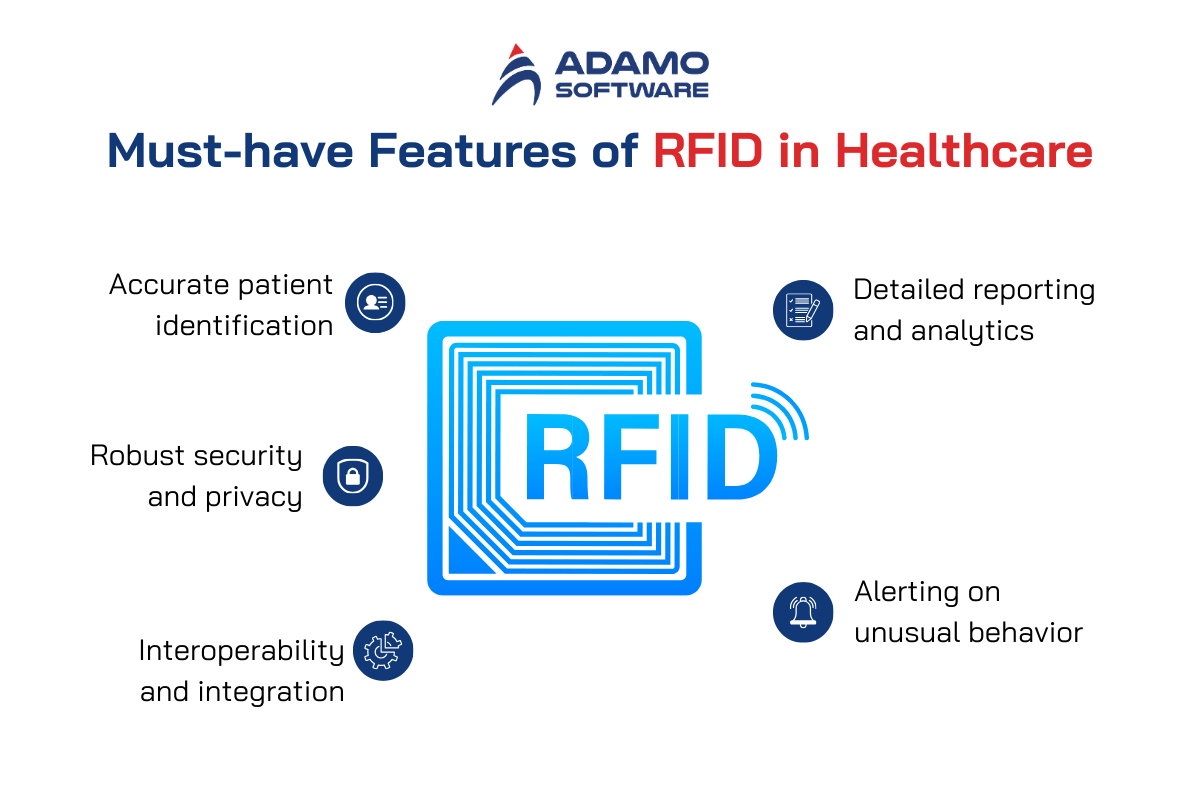
1. Accurate patient identification
Accurate patient identification is crucial for ensuring patient safety and reducing medical errors in healthcare. Thanks to RFID wristbands with unique identifiers, healthcare facilities can ensure that the correct treatments and medications are administered. The integration of RFID with electronic health records (EHR) facilitates seamless access to complete patient data. Thanks to that, healthcare institutions can improve the precision and dependability of patient care.
2. Robust security and privacy
Robust security and privacy are essential features of RFID in healthcare. They are needed to protect sensitive patient information and ensure compliance with regulations.
Strong encryption is crucial to protect RFID data from unauthorized access and cyberattacks, safeguarding patient privacy and data integrity. Besides, by implementing strict access controls, only authorized individuals can view or modify RFID data, enhancing system security and protecting patient privacy.
3. Interoperability and integration
Interoperability and integration are vital for the successful implementation of RFID systems in healthcare. They ensure seamless communication and data exchange between various technologies and platforms. The RFID system must be compatible with existing healthcare IT infrastructure.
4. Detailed reporting and analytics
RFID in healthcare must have reporting and analyzing features to provide valuable insights and data-driven decision-making capabilities. The system should produce detailed reports on patient movement, equipment utilization, and inventory levels to facilitate operational monitoring and optimization. The system must integrate advanced analytics tools to identify trends, inefficiencies, and potential issues. These detailed insights support improved resource management, enhanced patient outcomes, and streamlined operations.
5. Alerting on unusual behavior
Alerting on unusual behavior is also another outstanding feature of RFID in healthcare. By monitoring for irregularities, the system can detect issues like patients wandering into restricted areas, equipment malfunction, or unauthorized area entry. Once these abnormalities are detected, real-time alerts are generated and sent to healthcare staff. Thereby, they can send immediate responses and interventions to patients. Thanks to this feature, healthcare facilities can safeguard patient safety, optimize care delivery, and maintain a secure facility.
VII. How Adamo Helps You Develop RFID-Based Tracking Software
As one of Vietnam’s healthcare software development companies, Adamo Software can help you develop RFID-based tracking software in many ways. Partnering with us, you can completely trust the effectiveness we commit to. As our team includes professional developers, designers, and project managers, we will closely work with you to help you to adopt RFID in healthcare. Here’s how Adamo can help you.

- Customized solutions: tailoring RFID tracking solutions customized to meet the specific needs and requirements of your healthcare facility
- Creating user-friendly interfaces that enhance the ease of use and adoption by healthcare staff
- Supporting the integration with the existing healthcare system
- Developing systems that provide real-time tracking and monitoring of patients, equipment, and supplies
- Incorporating advanced analytics tools to identify trends, inefficiencies, and potential issues
- Designing the system to comply with relevant healthcare regulations and standards
- Ongoing support and maintenance
Still confused about choosing a unit to help you develop a robust, efficient, and secure RFID-based tracking system? Don’t hesitate to contact us for a consultation.







